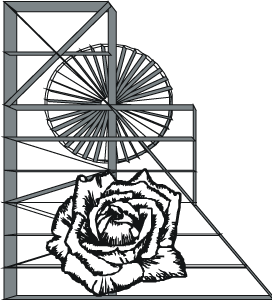About us
New Tredegar / Tredegar Newydd (from tre+tegyr+newydd)
Although “tre” or “tref” is more commonly the Welsh word for “town”, it can also be used for “farm” as in this case. Tegyr was the name of the farm from where the Tredegar family took their name (“tegyr” becoming “tegar” over time).
The original Tredegar was near Newport (Tredegar House was the location of the 2004 National Eisteddfod).
The Iron Works owned by the family in the Sirhowy valley gave rise to the town of Tredegar in Blaenau Gwent and the new houses built in the next valley became the village of New Tredegar, taking the name of the Colliery that opened there in 1858.
The area was built on the site of two farms, Aberysibwr and Cwmysibwr and was originally called White Rose. That name was preserved in the railway station White Rose in 1885, in the road name White Rose Way and now in the name of the new community School built in the area and opened in September 2004, White Rose Primary School.
The Winding House: home of history
In the mid-nineteenth century the coal industry swept into the Rhymney Valley. In the space of just a few years, its impact transformed the rural settlement of White Rose into the bustling mining town of New Tredegar.
The premier pit to open in New Tredegar was Elliot Colliery. Its west shaft was sunk 1883 and work on its east shaft began in 1888. At the head of the east shaft stood the East Winding House, within which was a magnificent steam winding engine. This was built in 1891 by Thornewill and Warham of Burton-on-Trent.
Engine number 603 was originally a twin cylinder horizontal steam engine. However in around 1904, this was upgraded to a more powerful and efficient horizontal tandem compound engine, complete with an unusual diablo winding drum.
At its peak Elliot Colliery employed around two thousand eight hundred people and produced over a million tons of coal per year.
A description in a mining magazine in 1895, stated that the East and West Pits “both produce steam coal of the best quality”. It was owned and managed by the Powell Duffryn Steam Coal Company Ltd. This was established in 1864 and operated many pits in the area.
Elliot Colliery sprawled across the valley both below and above ground. Below lay a complex system of roadways leading to and from the coalface.
Jump media playerMedia player helpOut of media player. Press enter to return or tab to continue.
Above was a myriad of surface plant and buildings, such as a network of railway sidings and conveyors, lamp room, explosives stores, workshops, the washery and screens and in later years, the pit head baths and canteen.
In 1967, Elliot Colliery closed. Its buildings were demolished and its machinery was sold off or scrapped. Fortunately, the East Winding House and its Thornewill and Warham steam engine escaped this fate. They stood alone as the last reminders of a now extinct local coal industry.
A match of buildings old and new comprise the Winding House museum. Already serving as a museum, the Winding House was refurbished and reopened in late 2008 as an expanded attraction exploring the history, heritage and culture of Caerphilly County Borough within a landmark building, filled with new services and facilities.
A fully equipped resource library and activity room supports a full and varied lifelong learning programme, fascinating talks and fun filled events.
Complementing all of these is the relaxing cafe bar and museum shop located in the welcoming glazed atrium. A key part of the project is the conservation work being carried on out on both the Grade II* listed winding house and its engine.
For further information please go to www.windinghouse.co.uk


